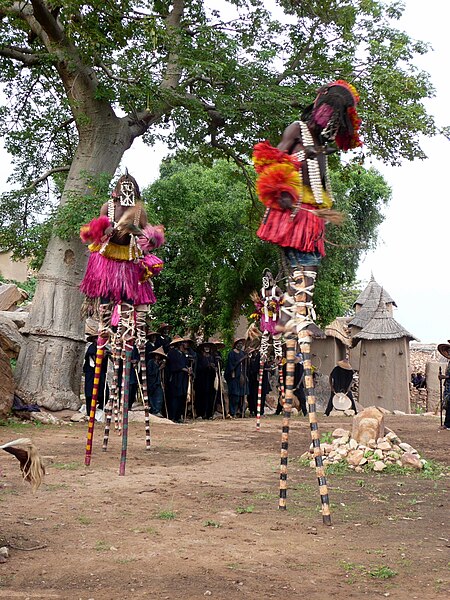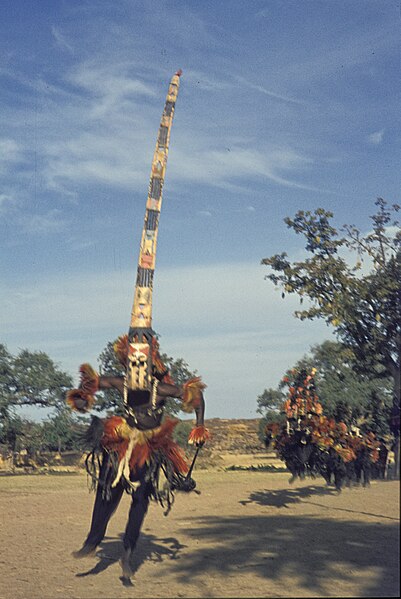Good day, dear Take in Mind readers! That’s it! Yes, our site has finally reached the “Dogon people” topic. A group of people whose cosmology over the past eighty years has been the tiebreaker or a card up their sleeve for both supporters and opponents of the theory of the extraterrestrial origin of life and contacts with aliens. How did we reach such a paradoxical situation? Let’s check it up.
To start from the beginning, we should collect some geographical and historical information: The Dogon are an ethnic group living in Mali, Côte d’Ivoire, and Burkina Faso. The population numbers between 400,000 and 800,000. Most of them keep the traditional beliefs, although there are some Christians and Moslems. The Dogon traditionally live in villages and their main occupation is agriculture. Blacksmithing, pottery, and traditional sculpture are also developed.
The village community consists of several large families and is governed by a council of senior men. The spiritual leader of the community is the priest (a Hogon) of the cult of Lebe, the sacred snake, who’s considered to be the mythical ancestor of the Dogon people. The Hogon is elected by the community and should pass through a long initiation process. Nommo is also considered the first ancestor and epic hero, who stole fire from the heavenly blacksmiths, divided the earth between the Dogon clans, and taught people to agriculture.

The Dogons have rich and original mythology. In addition to the above-mentioned Lebe and Nommo, it is necessary to mention Amma the Great God-Creator, the half-human-half-snake “water deities”, and Yurugu the harmful jackal. The Dogon cosmology is also very interesting and complicated. Thus, the Dogon people consider Sirius, a star in the Canis Major constellation, and its invisible companions as the most important objects in the sky.
Sirius, or “sigi toli” in Dogon languages, has a tiny invisible satellite. They call this object “po tolo”, or “deep beginning”. Earlier it was located in our solar system near the Sun, but then it left the Earth’s neighborhood together with other stars (luckily for us, the Sun was an exception). Despite that, this star is still the “center” of the sky and manages the rest of the Universe. Of course, it also manages Sirius’ behavior.
The Dogons claim that “po tolo” has a period of fifty years for a complete turnover. In addition, the “po tolo” star has its own, important and creative task: Its constant rotation brings new life in the form of the smallest grain. Dogons have closely associated the star with the fonio (Digitaria exilis) seeds, which is sometimes called the “fonio star”. Its tiny grains were the first of eight species of seeds, created by Amma the creator, and the “po tolo” star is exactly like them.
Now we come to the most interesting part! In accordance with our astronomical knowledge, Sirius has a small, extremely dense, and dull satellite – Sirius B, a white dwarf star, rotating together with the big star around the common center of gravity with a fifty years cycle. This satellite had remained unknown for modern astronomy until 1844 when the German mathematician and astronomer Friedrich Bissel theoretically proved its existence. In 1862, Sirius B was first noticed by telescopic observations.

It looks like that the Dogons are familiar with the known features of the Sirius system. Moreover, their scientific knowledge is illustrated by colorful ceremonies dedicated to its satellites. With a holy honor, they keep and use ancient ritual masks in these ceremonies. The information about these masks suggests that the rituals were conducted at least since the XIII century. How could the Dogons know about Sirius B before the invention of the mirror telescope?
Well, in our imaginary dispute between proponents and opponents of extraterrestrial civilizations, the first ones start to celebrate the victory. But please do not hurry up! Let us listen to the opponents as well. Their first question (and also an argument) is: How do we know all the details of the Dogon astronomy? Where this knowledge came from?
In 1931, the French anthropologist Marcel Griaule began to collect the Dogon folklore. Another French scientist, Germaine Dieterlen, joined him a few years later. Starting from 1947, these French scholars published a few very detailed works about the Dogon Universe. These include the description of Jupiter’s satellites, the Saturn ring, and many other space objects (whether we know about them or not). This intriguing information was immediately picked up by the supporters of UFO and aliens theories. Naturally, Griaule and Dieterlen became famous, not only among respected Africanists.

However, ethnographers who later visited the Dogons had not confirmed this information. Moreover, the scientists have not discovered any Super-astronomy, although, as it was claimed, they talked even with the same personages who Griaule talked with. So, there were some public claims that the Dogon’s history about Sirius B and other astronomical objects is either falsified or it’s the result of “cultural contamination”. Even if the Dogon cosmology is not the European “fake”, it is quite possible that it was adapted from other African nations. The Dogon people, in principle, have never lived in absolute isolation; for centuries the main trade route of West Africa passed through or close to their territory. Besides, some facts suggest that Dogon traditions are not ancient as they are assumed to be.
Thus, there are more arguments for a scientific-historical “falsification” than for the reality of the Dogon’s tremendous astronomical knowledge. Actually, at this point, it could be possible to announce the victory of the opponents of the extraterrestrial civilization, at least in this dispute, if not for one small “contra” argument which is…

According to Griaule and Dieterlen, the Dogon believe that there is also a third star in the Sirius system. Until recently, its existence was considered absolutely impossible. But in a 1995 article, French scientists Benest and Duvent (Astronomy and Astrophysics, 299: 621-628) presented the careful astrometric measurements providing evidence of a third star in the system – a Sirius C. Their work was neither confirmed nor completely refuted. That’s right, the later observations with the Hubble Space Telescope made it possible to exclude the existence of large objects orbiting Sirius A or Sirius B. In fact, there are almost certainly no objects larger than a small brown dwarf or a large exoplanet in the Sirius system.
However, these works have raised a doubt in the suggestion that the Dogon cosmology was falsified… So, once again we in Take in Mind should admit that it’s still very early to know the truth, and only the future will judge us. Will shall wait!
Featured image is licensed under the Creative Commons Attribution 3.0 Unported license.
Related Articles:
